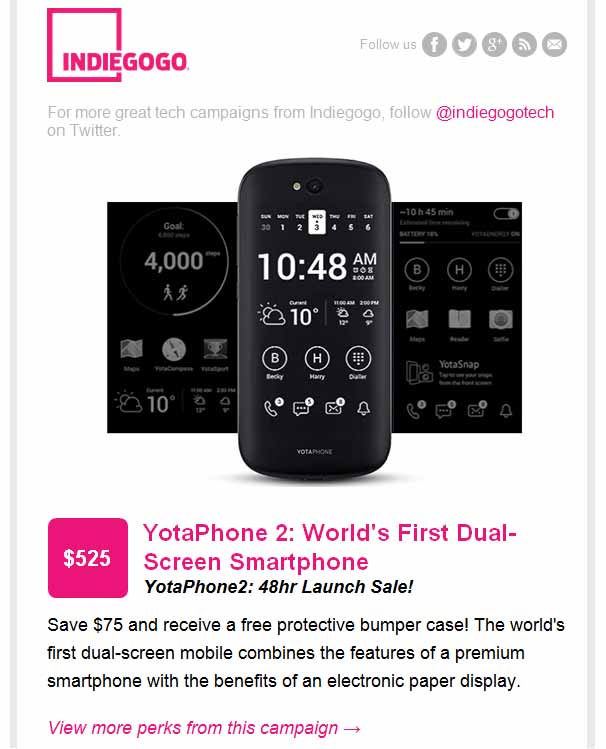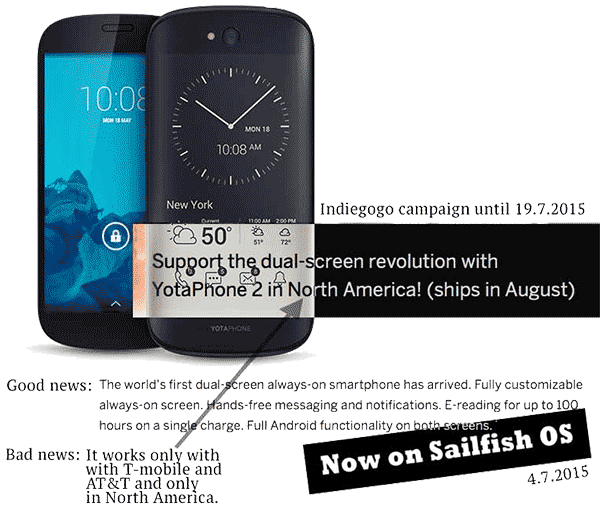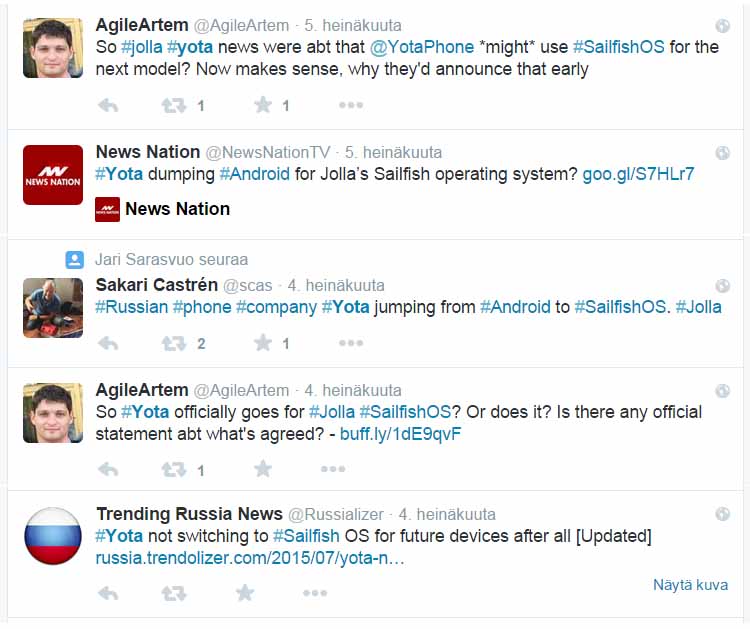
For a moment on July 4th 2015, Yotaphone was my choice for my next phone. But why only “was”?
Answering this and asking a few more questions on what’s going on in the business of mobile phones.
The above and a few other questions get answered in this snapshot of mobile tech history. Every day redefines the future. How much can happen in three days?
As a consumer and European citizen, I picked up a few news that attracted me. I recorded my thoughts over three days 4.-6.7.2015. The conclusion surprised me.
Returning from a holiday trip on July 4th, 2015, I checked my Inbox and found this friendly message from Indiegogo.
Indiegogo is one of my favourite sites, full of creative and innovative product ideas. If there are enough “contributors” who want to “select the perks” (the key terms of Indiegogo transactions), and if the development project succeeds, they they deliver a product that might however differ from the original specifications.
The headline is interesting. You sell the “World’s first Dual-screen Smartphone”? At least in some countries, that bold lies are illegal.
Just think of all the dual-screen phones. Nokia E90. Nokia 9300. Nokia 9210. Nokia 9110. I remember both of their screens. And there are many more dual screen phones between the first Nokians and YotaPhone. Take for example Kyocera Echo, Docomo Medias W, Samsung SCH-W2013,…
So, to start with, they seem to be less honest – and I lost my trust in their words.
I’ve seen this happening again and again. R&D creates a great product which fulfils true user needs. And then comes Marketing. By adding a few overly promising lies, the consumer experience turns negative. If they had phrased it “Yotaphone 2 dual-screen smartphone”, my first reaction had been purely positive.
I skip the negative feelings created by marketing comms, and get attracted by the design. Could this be my next phone?
Let’s take a look at www.indiegogo.com/projects/yotaphone-2-world-s-first-dual-screen-smartphone
(No, you better not click it! Stay with me 🙂
The story of Yotaphone
In Dec 2013, Yotaphone introduced a novel phone concept with an e-ink screen on the backside. That feature alone might have been a good enough reason for me to buy it: I am curious to experiment new interaction solutions.
Yotaphone 2 is being launched through an Indiegogo campaign in May-August 2015. It seems like a phone matching with my needs – so why not order it? Simply because I am not allowed to buy a Yotaphone 2. I am not part of their target segment. They scope out everybody outside North America. Even there, they limit their potential customers to AT&T or T-mobile customers.
I believe Yotaphone will later be willing to sell their phones also to people like me. By that time, people like me might however already be looking for something else. To be seen.
In the meanwhile, while writing this, tweeters told Yotaphone 2 will have Sailfish OS instead of plain Android (news on different sites 4.7.2015).
I quickly checked these articles.
- 9to5google.com/2015/07/04/yotaphone-ditches-android-jolla-sailfish-os
“Future YotaPhone handsets will have Sailfish OS instead of Android” [2015-07-04] - pocketnow.com/2015/07/03/yotaphone-drops-android
“Whether Jolla’s Sailfish OS will be made available for the current YotaPhone 2 model, or it will only run on future versions of the phone, is yet unknown.” - www.demanjo.com/news/technology/2390427/yotaphone-bids-farewell-to-android–welcomes-sailfish-os.html
“Yotaphone ditches Android to marry Sailfish. Russian manufacturer Yota, well known for its Yotaphone dual screen phones, has recently announced that its next flagship phone will no longer operate using Android but Sailfish, an alternative developed by former Nokia engineers at Jolla.”
Now – that is, since July 4th – I definitely wanted this phone. Sounded like perfect for my needs and wants. But the conclusion was too hasty. The next day – that is, today July 5th – the news were:
- www.androidcentral.com/yota-announces-switch-away-android-jollas-sailfish-os
“Yota not switching to Sailfish OS for future devices after all [2015-07-05]

And this piece of news changed the mindset again: No – this phone is not for me.
It is strange how the human mind works. A negative first impression might well later turn into a positive feel, once you learn to know it better. It being a person or a product, just the same.
However, if a positive impression turns later to negative, there is typically no way back to positive. The feel of disappointment, being betrayed – it stays permanently attached to the observed person or object.
This time Yota’s marketing is not to blaim for my negative feelings. The move to Sailfish was simply a fake gossip – and quickly corrected by a Twitter message from Trending Russia News. Wait a minute – Trending Russia News? I thought Yotaphone is made by some start-up company in sunny California. What’s the connection to Trending Russia? To be answered.
![]()
Let’s keep our minds for a few more seconds on Sailfish.
When I change my phone, I want the new phone to add value to my cumulative experiences. In plain English: The new phone must be different to earlier phones. On phones, my interaction experiences are limited to S30, S40, S60, later Symbians, iOS, Android and Windows phones.
As a consumer, I’d like to have a phone with Sailfish OS.
The above story of Yotaphone showed a couple of small hurdles: Firstly, they don’t sell me the phone, and secondly, even if they sold, they wouldn’t put Sailfish on it. I am slowly becoming well experienced in failing to get Sailfish. Continuing with this theme:

The story of a consumer trying to buy a Jolla
Some time ago I went to an expert store. Yes, of course we have some Jollas on the shelf. Yes, you can try it. Yes, it looks good. No, that is a fixed price.
I told I want to buy it. The salesman replied that I am one of their regular customers, also their CRM shows it. For that reason, he would rather not sell any Jolla to me. He told he had sold six Jollas so far, and five of those six had been returned because of technical problems. Selling problems is not good business, he explained. Good enough argumentation.
That’s why I have a Samsung Galaxy now. Because of being segmented as a frequent customer. No problem, I’ve been happy with my Galaxy.
![]()
Returning to here and now, this weekend. There is something in the air between Sailfish and Yotaphone, or not. What are the companies behind these products?
Summarising Jolla and Sailfish backgrounds:
- Sailfish is made by Jolla, a Finnish company established and run by ex-Nokia experts of mobile SW design.
- Finns are an honest, reliable and persistent nation, known for their innovativeness in high-tech. (My conclusion: I’m sure we will some day see Sailfish OS on 3rd party phones.)
- Headquartered in Helsinki (Finland), Jolla has R&D offices in Helsinki, Tampere (Finland) and Cyberport Hong Kong. They are establishing R&D operations also in China.
-
History of Jolla:
- While Nokia still dominated the smartphone market with its S60 (Symbian) phones, they decided to base Nokia’s next generation high-end operating system on Linux. This project was called Maemo.
- After merging Maemo with Intel’s open source Linux project called Moblin, the project was renamed to MeeGo.
- Thanks to Stephen Elop’s famous strategic creativity, Nokia lost the smartphone markets with a sudden kill.
- The publicly known starting point was Elop’s oilrig speech for the personnel at Nokia House in Espoo, Finland. If you were not there, you can read it at blogs.wsj.com/tech-europe/2011/02/09/full-text-nokia-ceo-stephen-elops-burning-platform-memo/. In this speech, Elop did in fact not yet reveal the strategy – he only raised the media interest for the actual bomb to be thrown on Feb 11th.
- The vision agreed by Elop and his VPs in early 2011 – and after the oilrig speech communicated also to personnel – was to “continue Symbian sales as long as Symbian phones continue to bring in cash”. Windows would be an add-on to Nokia’s portfolio of platforms. Symbian was told be a good cashcow which would be maintained with upgrades for at least several years.
- Three Symbian upgrades were already in the R&D pipeline with code names Anna, Bella and Clara. These would significantly improve the user experience within a year. All looked still good internally.
- When Elop went public on Feb 11th, 2011, he surprised the audiences both inside and outsid Nokia. Elop announced that Nokia will ramp down Symbian and replace it with Windows. At this moment, the R&D development of the first Windows phone had barely started.
- The outcome was very logical. Immediately after Elop’s message reached telecom operators and phone retailers, they started to cancel their Nokia orders. Nokia’s smartphone cash inflow collapsed.
- In theory, this change in smartphones business would not directly affect Nokia’s main income from basic phones based on S30/S40. However, on retail level , the Nokia brand was seen as one. The loss of tech leadership image got reflected also in basic phone business.
- Now things started to roll fast in Nokia:
- Symbian R&D department was sold to Accenture which then later fired the people.
- Nokia announced that it will fire a substantial amount of its personnel. (And they did. Alone in 2011-2012, Nokia laid off 50.000 people.)
- Nokia started a career-planning and funding program”Bridge” which helped the to-be-fired Nokia employees to establish start-up companies.
- Nokia Bridge was like the reality-TV program Dragon’s Den: you had to convince a team of assigned Bridge people that your business idea is worth the funding and can survive.
- In October 2011, the core of the MeeGo team left Nokia to form Jolla, utilizing the support of Bridge. The Jolla founders were Sami Pienimäki, Jussi Hurmola, Marc Dillon, Stefano Mosconi and Antti Saarnio.
- Jolla got 10M€ funding also from TEKES, a funding organization which supports emerging technology projects and young innovative companies.
- Jolla recruited dozens of developers who used to work in MeeGo and other smartphone development teams: interaction and graphic designers, usability engineers, industrial designers, software architects and programmers,…
- And as their Chief Designer they hired Martin Schüle, a worldclass talent who had earlier worked for Linja Design (a distinguished pioneer company of digital interaction, already in 1990s) and, naturally, also Nokia (the distinguished pioneer company of mobile communications, already in 1990s. No, I mean 1980s. Or was it 1970s? No, I think it was 1968 when they were mature enough with digital comms to launch the revolutionary digital multiplexing of 64 analog phone channels into one 2Mbit/s digital stream, known as PCM, pulse code modulation. Sorry for the sidepath – my former boss was one of those inventors and I have heard the story for a few times. My boss was also an excellent bridge player.)
- Sailfish OS was presented publicly in November 2012 and its development kits became downloadable in February 2013. By that time, Jolla had 70 employees.
- Jolla’s plan was to be a SW platform provider for other companies who manufacture phones. However, they first needed a showcase. For this need, they created the Jolla phone to present what one can do with Jolla platform.
- Jolla company started to ship Jolla phones in November 2013.
- Jolla tablet was announced at indiegogo.com in November 2014. Jolla tablet should be released in July 2015 (But not seen this yet by the time of writing this, on July 6th).
- Sailfish OS can be used on any hardware with a Linux kernel supported by the Mer core distribution. By July 2015, Sailfish OS had been ported to 16 devices, including models from e.g. Acer, Google Nexus, HTC and Samsung.
- Using Myriad‘s Alien Dalvik virtual machine, Sailfish can run also Android applications.
Summarising Yota and Yotaphone backgrounds:
- Yota is a Russian company and a Russian mobile broadband service provider. Consequently, they have enough cash to develop a phone or two.
- The values and business goals of Yota are… not known publicly. Russians are anyway a well-known nation by many of their neighbor countries. I believe I don’t offend anyone by saying that assumingly Yota’s business values do not greatly differ from the general Russian values.
- It has been rumoured that Yota plans to move their headquarters to Canada (Source: en.wikipedia.org/wiki/Yota). The reasons might include image building and financial goals.
-
History of Yota
- Based on wikipedia articles, I summarize here what is known publicly about the company. (links below copied from Wikipedia, credits to their original authors)
- Yota was established by a St. Petersburg based company Korus, owned by Denis Sverdlov, and businessman Sergey Adoniev.
- Garsdale Services Investment Ltd owns 100% of Yota shares
- Garsdale Services are based in the British Virgin Islands
- Garsdale Services itself is 82% controlled by AF Telecom
- Garsdale Services also owns 100% of Skartel shares and 50% or Megafon shares. Both of these companies are also Russian.
- As a name, Yota is a trademark owned by Skartel.
- Megafon is a big Russian operator. Megafon is not a public company, therefore it does not have to disclose much information on the company’s business.
- Of the Megafon, AF Telecom (owner Alisher Usmanov) owns 8% shares directly and 23% through Telecominvest
- Altimo (owned by Alfa Group) is Megafon’s 2nd biggest known owner with 25% share.
- A Danish lawyer Jeffrey Galmond publicly claims to own and control Telecominvest, but he is believed to in fact represent the personal interests of former Russian telecommunications minister Leonid Reiman. (referring to the Finnish newspaper Helsingin Sanomat: Venäläisministeri paljastui TeliaSoneran liikekumppaniksi Russian minister is revealed as TeliaSonera‘s secret business partner in Russia – Helsingin Sanomat 24 May 2006). A battle for control of the company would be ongoing between Alfa Group and Jeffrey Galmond‘s party.
- Yotaphone was launched in Dec 2013, to become the first Russian mobile phone (phys.org/news/2013-12-russian-smartphone-dual-screen-yotaphone-moscow.html)
- Yotaphone 2 was launched a year later. Verge’s excellent review described it in Dec 2014 www.theverge.com/2014/12/5/7338753/yotaphone-2-hands-on-preview
- Now (June 6th, 2015), 950 people have participated the Indiegogo campaign, expecting to get their Yotaphone 2 around August 2015. The Russian phone targeted only to North American customers.
- Trying to find the meaning of the name Yota I bounce into this: “…a scandal involving a Russian WiMax provider Yota that blocked access to few dozens of oppositional Web sites.”
- Being just an expert of user experience, not political science, I won’t make any further conclusions.
- For those interested in politics, russianpoliticsfordummies.wordpress.com provides the English translation of Kommersant’s (Russian newspaper) interview with Sergei Adoniev in 2009. That’s Yota.
![]()
So? Jolla’s Sailfish and Yota’s Yotaphone – these two seem to be based on different cultures indeed 🙂 No wonder if they don’t easily get together. In fact, a too close relationship of Sailfish and Yotaphone might even be harmful for Sailfish OS in the long run. The next big mobile tech wave might be in communication that people fully trust on. Here’s one potential customer:
And naming the trust leads us to a new topic…. Somebody just tweeted about a new Finnish company called Bittium. For those reading Finnish fluently, here are the first articles on the emerging company
- www.hs.fi/talous/a1305929938700 (published 20.2.2015 newspaper Helsingin Sanomat)
- www.kaleva.fi/uutiset/oulu/elektrobitista-tuli-bittium/701147/ (published 2.7.2015 newspaper Kaleva)
Bittium’s business has its roots in Elektrobit (located in Oulu, Finland). Elektrobit was started in 1985 as a subcontractor of Nokia SW and HW and gradually they grew big with Nokia. Just recently Elektrobit was split into two companies.
Simplified: the electronics continue in Elektrobit, and the bits continue in Bittium.
Looking more closely, it is more complicated (though not as cryptic as with Yota): Elektrobit sold its Automotive division to Continental AG (Germany). With this deal, they also sold the name Elektrobit. Thus, the remaining company had to be renamed, becoming the Bittium. Logical. And now we come to the point, revealing what used to be a big secret until this week:
First reported by Kauppalehti (Finnish business newspaper) on 1.7. and 6.7.2015, Bittium Tough Mobile will be a very special phone: it will ensure secured communication.
Bittium’s primary target customers are consequently in military, security and public administration – people whose calls must not leak. If one tries to hack the device in any way, the device will destroy its own data. One of their first customers is the Mexico Ministry of Communications. They have made an R&D order worth of 19.5 M€. Bittium’s target customer segment is by purpose quite small. I don’t believe I will ever own a Bittium. They wouldn’t sell to me.
![]()
Considering the above cases side-by-side – conclusions?
Three different products, three different companies. One common factor.
It is no more the buyer who chooses the product. It is the seller who chooses to whom to sell.
I sense something new emerging. I was tought the old-fashioned marketing, and there segmentation was then regarded as a tool to channel and promote sales. Now segmentation is increasingly used to restrict wrong customers from buying your products.
![]()
Learnings from the viewpoint of blogging?
This post was a true mindflow. At the top of this page I was just fascinated of the dual face of Yota. Sorry, I meant dual screen. And I thought they are a small company from USA.
While I was writing, the hot news about Yota and Sailfish started to twitter around. I got curious about Yota’s background, and just to keep my story in balance, looked into Jolla’s background too.
Just by coincidence, the news about Bittium’s product scope were also revealed during the same weekend.
History is always written afterwards, and first then you give meanings to what happened. These days – just like any other days – may have included some major turning points for the mobile tech history. To be seen, perhaps first much later.
Likewise, it is hard to predict which products will change the world, and which will just buzz around and disappear. Will we remember Yotaphone of its e-ink screen? Or a secret feature specified by KGB? Did Sailfish say no to Yota because of political reasons? Did that save Jolla, or harm it? Will Yotaphone’s secret feature (once found in the future) then boost the desire for hard-secured phones, filled by the Bittium products? The future might throw us back to these topics later.
The mood of this post changed gradually. I started by walking around in the sunshine and suddenly I found myself in the middle of an agent story. Perhaps too deep: When the download of an inserted image failed – for the first time ever – I wondered if someone at Yota has noted my draft post that I just published and asked their friends to hack my server.
I found new questions. The latest being if I should buy Bittium shares. They are listed at Helsinki Stock Exchange, running at 4.69€ per share at the moment.
Obviously the post would become better if rewritten. All the above was written as a mindflow – sentences flow in chronological order. To make this a more influencal and memorable post, I should now outline a synopsis applying some old good story pattern, and then rewrite the whole post. Something like this:
The Body with Two Souls:
 During the weekend of June 4th and 5th, 2015, Yota was announced to have an affair with Jolla. /
During the weekend of June 4th and 5th, 2015, Yota was announced to have an affair with Jolla. /
All their friends were happy and waited for their marriage. /
On Monday morning, Yota denied everything. /
Yota explained:
I love only you, Android.
With Jolla, we were just doing some business.
The Famous Five and the Burning Platform:
In the middle of the Red Ocean, a team of five men survived from the burning platform with a jolla *) /
The five saved a hundred more people before the top platform collapsed,
crushing down also the lower level platforms. /
 They wondered if the captain himself had turned the place in fire
They wondered if the captain himself had turned the place in fire
as he had abandoned the place with a pre-booked helicopter /
Guided by the desire to find a sailfish,
the jolla started sailing towards the Blue Ocean. /
When they finally found the sailfish and touched it, it turned to gold. /
The captain returned to serve the man whose name turns into “666” when counting the ASCII values. /
It was however a double betrayal: The captain was now himself fired. /
And no tweet was heard from the captain ever after.
*) Jolla is Finnish word meaning a dinghy, a small agile boat.
![]()
And finally, below we have captured a snapshot of Bittium.
In the illustration below, we see Bittium jumping over the waves towards the same Blue Ocean where Jolla headed earlier. Will they meet – will Bittium possibly bounce on the Sailfish? The stories will continue.

![]()
Please comment. The comment will appear below in an hour or in a few days, depending on Jussi’s laptop whereabouts.




Pingback: Click here for shortcuts to all posts | Experiences by Jussi